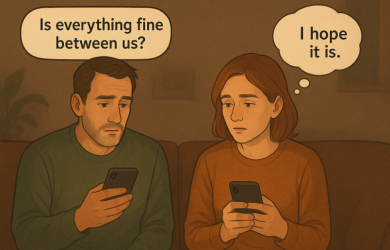9 Cannon-Bard Theory of Emotion Insights for Couples

Unlock Daily 30-Sec Tips for a Happier Relationship
👉 Subscribe FREEKey Takeaways
Marriage.com AI Quick Summary
Ever felt your heart race and your cheeks flush… all at once, right in the middle of a simple conversation with your partner?
It’s wild how the body and mind team up like that—fast, fierce, and sometimes confusing. Love isn’t just sweet words or quiet dinners; it’s also the shared silences, the sharp glances, and the unexpected tears.
Emotional moments between couples can feel intense, even when they’re small. And while we all try to “stay calm” or “talk it out,” sometimes it helps to understand what’s happening underneath.
That’s where the Cannon-Bard theory of emotion slips in—not as a solution, but as a lens. A gentle way to see that maybe… your reactions aren’t random. Perhaps they’re just deeply human.
What is the Cannon-Bard theory of emotion?
So… what’s really going on when your heart pounds and your emotions spike at the same time?
You’re not overreacting—it’s just how your body and brain work together. According to the Cannon-Bard theory of emotion in psychology, we don’t feel first and react later; instead, emotions and physical responses show up side by side and in sync.
That tight chest?
That flood of frustration or joy?
They’re not waiting in line—they’re dancing in unison. It’s not about control, really—it’s about noticing the whole picture, all at once, as it unfolds.
The Cannon-Bard theory proposes that emotions arise from the thalamus in the brain, not the peripheral nervous system. When environmental stimuli activate sensory organs, the thalamus sends signals to the cortex for emotional experience and to the body for physiological responses.
9 Cannon-Bard theory of emotion insights for couples
Emotions in relationships can be tricky. They sneak up, come in strong, and sometimes leave us wondering—”Why did I react that way?” or “Why did they shut down so fast?” That’s where understanding emotional responses can help.
The Cannon-Bard theory of emotion offers a comforting reminder: our feelings and body signals often show up together, not one after the other. And when couples get curious about that connection, they tend to find more compassion… and a little more patience, too.
1. Emotions and body reactions happen at the same time
You’re not imagining things—your heart can race as you feel fear, sadness, or joy. The Cannon-Bard theory of emotion says these emotional and physical reactions don’t follow each other; they arrive together like a matched set.
So when your partner tears up during a heartfelt talk, it’s not “too much” or “dramatic”—it’s just how their body processes emotion. Understanding this makes room for tenderness. It reminds you that reactions aren’t always calculated—they’re beautifully human.
- Try this together
When one of you gets emotional, pause and gently describe what’s happening in your body before diving into the “why.” This helps both of you understand what’s really going on—beyond just words. It builds emotional safety and a deeper connection in the moment.
2. One trigger can cause different feelings in both of you
You and your partner might experience the same moment very differently. One may feel anxious, the other excited. That’s totally normal! The brain’s processing center—the thalamus—fires off signals based on internal wiring, not shared logic.
The Cannon-Bard thalamic theory of emotion explains how our minds can interpret the same situation through completely unique lenses. Couples who respect those differences create safer emotional spaces to grow and connect.
- Try this together
Next time you disagree on how something “felt,” each of you takes 30 seconds to name your own reaction—without interrupting or correcting the other. Let it be a listening practice, not a fixing one. You’ll learn how different love can look and still be true.
3. Emotional responses aren’t always easy to “control”
Have you ever tried to not feel angry or told your partner to “just relax”? It rarely works. That’s because emotions and physical signals like tension or tears show up automatically. You’re not weak for feeling intensely; you’re wired that way.
The Cannon-Bard theory shows that control isn’t the goal—awareness is. Once couples accept that emotional flare-ups happen because of the body’s response, they can focus on coping instead of blaming.
- Try this together
Create a shared phrase like “wave passing” to signal you’re feeling something big but not ready to talk—this keeps space open without pressure. It’s a gentle way to say, “I’m overwhelmed, not walking away.” Use it to build trust around emotional timing.
4. Emotions don’t wait for logic to catch up
You might feel hurt before you’ve had time to understand why. That’s not immaturity—it’s biology. The body reacts in real-time, and logic often lags behind.
If your partner gets defensive quickly, it may not mean they don’t care—it could just be a simultaneous emotional-physical response they didn’t see coming. Giving each other a little room to process can calm the storm without pushing love away. Sometimes, silence isn’t distance—it’s decompression.
- Try this together
Build in a “2-minute pause” during tough conversations. No talking—just breathing. Let the nervous system settle so your heart can speak more clearly. Sometimes, silence clears the path for softer words and better understanding.
5. Physical cues can be misunderstood
Raised voices, flushed faces, or silence—all of these can be misread. Your partner’s stillness during a fight might look like withdrawal… but it could be their body’s reaction to overwhelm you. The Cannon-Bard framework helps couples pause before assuming the worst.
Emotions and body cues don’t always reflect intent; sometimes, they just reflect overload. Slowing down to check in—”What are you feeling?”—can reveal more truth than a hundred assumptions.
- Try this together
When one of you pulls back, ask gently, “Is this about me or something in you?” This simple question can shift the energy without creating blame. It makes room for curiosity instead of assumptions—always a healthier place to start.
6. Shared emotional moments deepen intimacy
Have you ever cried with your partner—happy tears, sad ones, or just messy middle-of-the-night confessions?
That’s bonding in action. When couples feel together through joy, grief, and stress, they reinforce emotional intimacy. According to the Cannon-Bard theory, those shared experiences activate both the mind and body in unison.
Research indicates that shared reality with close partners reduces uncertainty and enhances meaning in life and work. Across five studies—including romantic dyads, Black Americans, and frontline healthcare workers—findings show both correlational and causal evidence that shared understanding promotes meaningfulness by diminishing environmental ambiguity.
It’s not just “going through something.” It’s feeling something with someone. And that… that builds a kind of closeness words can’t always reach.
- Try this together
Watch an emotional movie or revisit a meaningful memory and talk about what comes up—not just thoughts but body sensations, too. Saying, “My chest felt tight” or “I felt calm,” invites your partner into your felt experience, not just your opinion.
7. Different emotional wiring doesn’t mean disconnection
Some people feel emotions strongly and express them outwardly, while others feel just as deeply but quietly. Neither is right or wrong. The Cannon-Bard theory reminds us that emotion isn’t measured by volume—it’s measured by presence.
So, if your partner doesn’t cry when you do, it doesn’t mean they don’t care. They just process differently. Recognizing this can replace disappointment with understanding.
- Try this together
Share one thing you usually feel but don’t say out loud. Let your partner into your inner world without needing a big reaction in return. You’re not asking for a solution—just to be seen, softly and honestly.
8. Real empathy includes physical awareness
Empathy isn’t only about “I hear you.” It’s also about “I see what you’re feeling—in your face, your posture, your silence.” The body tells stories that emotions don’t always tell out loud.
When you’re attuned to your partner’s nonverbal responses, you deepen your emotional fluency. This kind of awareness grows when couples learn that physical reactions are just as real as spoken ones. Trust builds when partners feel seen, not just heard.
- Try this together
Spend 60 seconds sitting face to face. No talking—just noticing. Afterward, share one thing you picked up in the other’s body language. It’s a quiet exercise that opens your emotional radar and deepens your connection beyond conversation.
9. Responding gently is better than reacting quickly
You don’t have to fix your partner’s feelings. Sometimes, just not escalating helps more. When someone is feeling big emotions—and their body’s in it, too—they need space, not solutions.
The Cannon-Bard theory encourages presence over pressure. You can say, “I’m here,” instead of “Calm down.” Letting emotions move through naturally, without shame, creates space for repair… and even quiet joy.
- Try this together
Practice saying, “That sounds hard—I’m here if you need me,” when emotions run high. There is no fixing, no rushing, just presence. This simple line can feel like a lifeline when someone’s overwhelmed—it says, “I’ve got you,” without smothering.
Can couples use this theory for emotional growth?
Imagine feeling truly seen and understood by your partner—not just in love but also in how you both view the world. That sense of shared reality can do wonders. It reduces the “unknowns,” eases emotional tension, and creates space for deeper meaning.
Over time, this shared understanding becomes emotional soil where growth happens—individually and together. You do not need perfect alignment; just openness, curiosity, and a little effort… and suddenly, life feels more meaningful, more connected, more “us.”
Watch this video where Dr. Maika Steinborn explains how you can be more mature in your relationship:
Sync hearts, not just bodies
Emotions are not just reactions—they are signals, invitations, and chances to connect. The Cannon-Bard theory of emotion reminds us that feelings and bodily responses unfold together… but in relationships, they do not have to unfold alone.
When couples tune into each other’s inner worlds, they create more than chemistry—they build emotional safety. It is not just about holding hands; it is about holding space.
So take a breath, share that feeling, lean in a little closer. Because when your hearts sync—not just your bodies—that’s where real intimacy begins.
And honestly, isn’t that what love is all about?
 Tips
Tips
Write your tip or submit a video tip
All tips are reviewed before the publishing.
Share this article on
Want to have a happier, healthier marriage?
If you feel disconnected or frustrated about the state of your marriage but want to avoid separation and/or divorce, the marriage.com course meant for married couples is an excellent resource to help you overcome the most challenging aspects of being married.
Related Quizzes
Unlock Daily 30-Sec Tips for a Happier, Healthier Relationship
👉 Subscribe FREE on YouTube We'd love your feedback!
We'd love your feedback!
 Expert Q&A
Expert Q&A
Ask your question related to this topic & get the support you deserve from experts.















 Thanks for your feedback!
Thanks for your feedback!